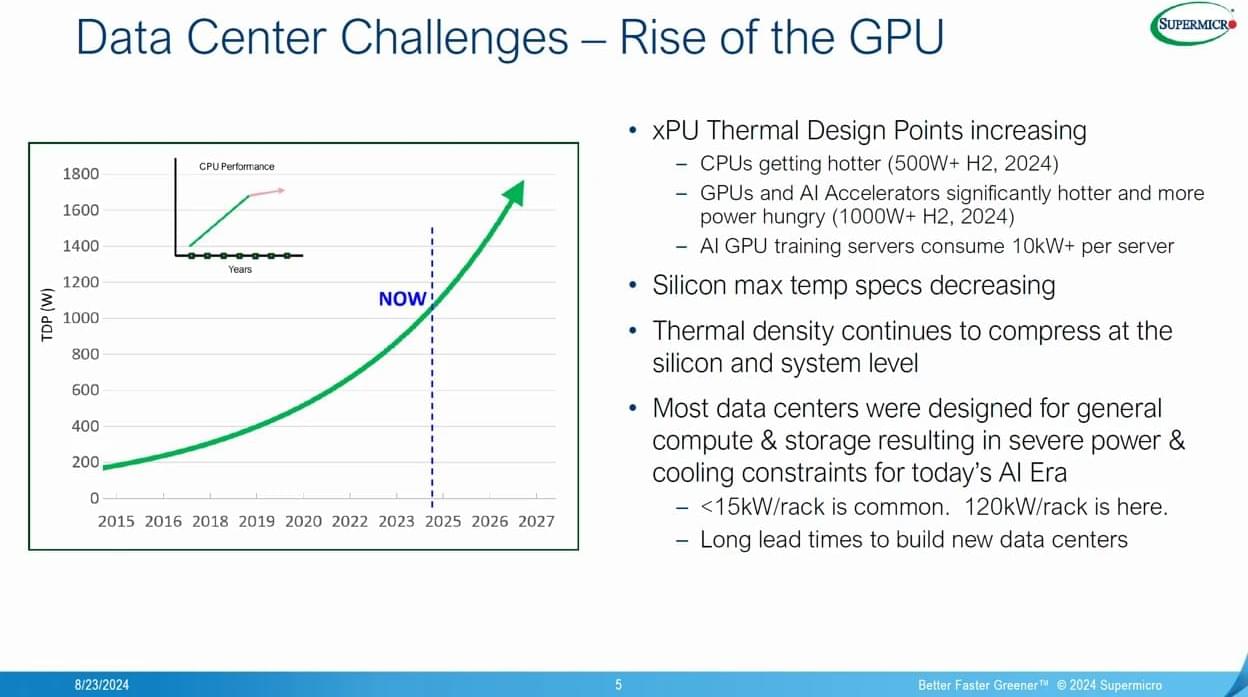Yoshua Bengio and Max Tegmark, two of the world’s most prominent AI scientists, warned of the dangers of uncontrollable artificial intelligence.
Category: robotics/AI – Page 191

Liquid Cooling, Meeting The Demands Of AI Data Centers
Adopting liquid cooling technology could significantly reduce electricity costs across the data center.
Many Porsche “purists” reflect forlornly upon the 1997, 5th generation, 996 version of the iconic 911 sports car. It was the first year of the water-cooled engine versions of the 911, which had previously been based on air-cooled engines since their entry into the market in 1964. The 911 was also the successor to the popular air-cooled 356. For over three decades, Porsche’s flagship 911 was built around an air-cooled engine. The two main reasons often provided for the shift away from air-cooled to water-cooled engines were 1) environmental (emission standards) and 2) performance (in part cylinder head cooling). The writing was on the wall: If Porsche was going to remain competitive in the sports car market and racing world, the move to water-cooled engines was unavoidable.
Fast forward to current data centers trying to meet the demands for AI computing. For similar reasons, we’re seeing a shift towards liquid cooling. Machines relying on something other than air for cooling date back at least to the Cray-1 supercomputer which used a freon-based system and the Cray-2 which used Fluorinert, a non-conductive liquid in which boards were immersed. The Cray-1 was rated at about 115kW and the Cray-2 at 195kW, both a far cry from the 10’s of MWs used by today’s most powerful supercomputers. Another distinguishing feature here is that these are “supercomputers” and not just data center servers. Data centers have largely run on air-cooled processors, but with the incredible demand for computing created by the explosive increase in AI applications, data centers are being called on to provide supercomputing-like capabilities.

Mapping minerals remotely: how hyperspectral imaging can support exploration
Discovering new deposits of critical and rare earth minerals is paramount to delivering global net-zero ambitions. However, finding new ore bodies is becoming more challenging due to increasing costs and geopolitical tensions. What is more, much of the low-hanging fruit, so to speak, has already been exploited.
Could technological advances help broaden the search and speed up the process? Dr Bryony Richards, a senior research scientist with the Energy & Geoscience Institute at the University of Utah in the US, believes so.
Richards and her colleagues are incorporating NASA’s and Japan’s global Advanced Spaceborne Thermal Emission and Reflection Radiometer (ASTER) imagery with that of new satellite data, advances in computing power and AI. With this approach, they are developing a comprehensive first-of-a-kind method to uncover the ‘fingerprints’ of mineral deposits that could eventually provide a more cost and time-effective way of mapping minerals in remote areas.
Researchers in Utah are combining satellites, hyperspectral imaging and AI to discover mineral deposits in remote locations.
Jensen Huang Introduces Blue: NVIDIA & Disney Research’s AI Robot | GTC 2025
At GTC 2025, NVIDIA CEO Jensen Huang introduced Blue, a cutting-edge AI-powered robot developed in collaboration with Disney Research and Google DeepMind. Watch as Jensen interacts with Blue and discusses this exciting partnership. While details are scarce, this brief moment showcases NVIDIA’s vision for the future of AI and robotics.
📺 Subscribe for more tech updates!
#NVIDIA #GTC2025 #AI #DisneyResearch #WaltDisneyWorld.
Thanks For Watching!
========================================================
Follow us on:
Website: http://samsdisneydiary.com/
FACEBOOK: https://web.facebook.com/SamsDisneyDiary.
…
INSTAGRAM: https://www.instagram.com/SamsDisneyDaily.
…
=========================================================
3D printing approach strings together dynamic objects to assemble bionic robots, sculptures and more
It’s difficult to build devices that replicate the fluid, precise motion of humans, but that might change if we could pull a few (literal) strings. At least, that’s the idea behind “cable-driven” mechanisms in which running a string through an object generates streamlined movement across an object’s different parts. Take a robotic finger, for example: You could embed a cable through the palm to the fingertip of this object and then pull it to create a curling motion.
While cable-driven mechanisms can create real-time motion to make an object bend, twist, or fold, they can be complicated and time-consuming to assemble by hand. To automate the process, researchers from MIT’s Computer Science and Artificial Intelligence Laboratory (CSAIL) have developed an all-in-one 3D printing approach called “Xstrings.” Part design tool, part fabrication method, Xstrings can embed all the pieces together and produce a cable-driven device, saving time when assembling bionic robots, creating art installations, or working on dynamic fashion designs.
In a paper to be presented at the 2025 Conference on Human Factors in Computing Systems (CHI2025), the researchers used Xstrings to print a range of colorful and unique objects that included a red walking lizard robot, a purple wall sculpture that can open and close like a peacock’s tail, a white tentacle that curls around items, and a white claw that can ball up into a fist to grab objects.


Google Acquires Wiz for $32 Billion in Its Biggest Deal Ever to Boost Cloud Security
Google is making the biggest ever acquisition in its history by purchasing cloud security company Wiz in an all-cash deal worth $32 billion.
“This acquisition represents an investment by Google Cloud to accelerate two large and growing trends in the AI era: improved cloud security and the ability to use multiple clouds (multicloud),” the tech giant said today.
It added the acquisition, which is subject to regulatory approvals, is meant to provide customers with a “comprehensive security platform” that secures modern IT environments.

With brake-by-wire from Bosch to the Arctic Circle
Plymouth, Mich. – For six days, over 2,050 miles and through different climate zones to the Arctic Circle: On an unusual test drive, a Bosch development team successfully tested the new hydraulic brake-by-wire system from Bosch for the first time on public roads. What sets brake-by-wire apart: This solution completely eliminates the mechanical connection between the brake pedal and the brake system. The driver’s brake request is transmitted to the brake-by-wire system purely as an electrical signal via redundant signal lines. For this fundamentally new approach, Bosch offers a robust and efficient solution with two independent hydraulic brake actuators – a by-wire brake actuator and an ESP®. Today’s brake systems, such as the integrated power brake from Bosch, still ensure the required redundancy in the event of a fault via a mechanical connection to the brake pedal. This coupling via an input rod to the brake pedal is eliminated in the new Bosch brake-by-wire solution.
Advantages of the Bosch brake-by-wire system
New freedom in installation: Due to the omission of the mechanical connection, there is no longer any need to mount the brake system components at the vehicle’s firewall. Instead, the components can now be installed where it is most optimal in terms of crash safety, NVH, and manufacturing. The flexibility in choosing where to install the brake actuators helps to avoid the need for different variants for right-hand and left-hand drive vehicles. By-wire technology enables new pedal concepts with significantly shorter brake pedal travel to create space for new interior designs. The hydraulic brake-by-wire solution from Bosch is based on proven brake system technology and is a combination of a by-wire brake actuator and an ESP®. Its slim design saves installation space and reduces the weight of the brake system. Since both the by-wire brake actuator and the ESP® are assigned to different channels of the redundant electrical system, they can each independently build up the required brake pressure at all four wheel brakes in the event of a fault. Therefore, this Bosch solution is also suitable for highly automated vehicles, meeting the protection of the brake system required for safety reasons.

NVIDIA Announces Spectrum-X Photonics, Co-Packaged Optics Networking Switches to Scale AI Factories to Millions of GPUs
SAN JOSE, Calif., March 18, 2025 (GLOBE NEWSWIRE) — GTC — NVIDIA today unveiled NVIDIA Spectrum-X™ and NVIDIA Quantum-X silicon photonics networking switches, which enable AI factories to connect millions of GPUs across sites while drastically reducing energy consumption and operational costs. NVIDIA has achieved the fusion of electronic circuits and optical communications at massive scale.
As AI factories grow to unprecedented sizes, networks must evolve to keep pace. NVIDIA photonics switches are the world’s most advanced networking solution. They integrate optics innovations with 4x fewer lasers to deliver 3.5x more power efficiency, 63x greater signal integrity, 10x better network resiliency at scale and 1.3x faster deployment compared with traditional methods.

Private Starlab space station moves into ‘full-scale development’ ahead of 2028 launch
“Our successful PDR is a testament to the expertise and dedication of our team,” Starlab CEO Tim Kopra said in the statement. “This milestone confirms that our space station design is technically sound and safe for astronaut crewed operations. Now, with our partners, we shift our focus to the full-scale development of the station, including the manufacturing of critical hardware and software integration.”
The 12,000-cubic-foot (340-cubic-meter) Starlab will be fitted with a robotic arm and a set of racks for microgravity experiments to enable companies and researchers to develop new products in space. Voyager also hopes to seal a contract with NASA to host the agency’s astronauts.